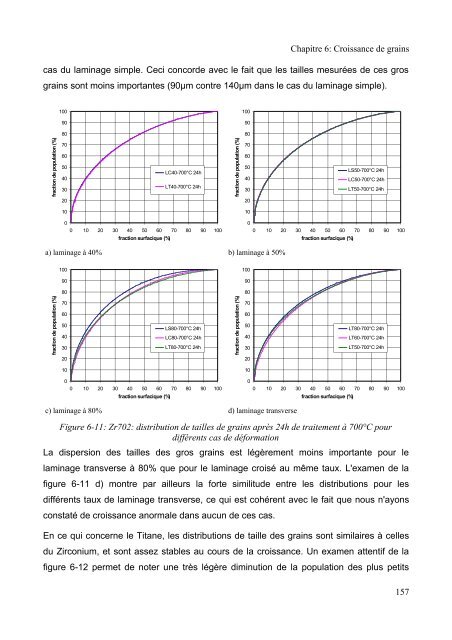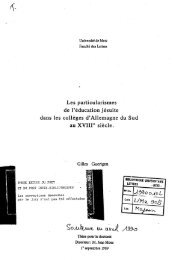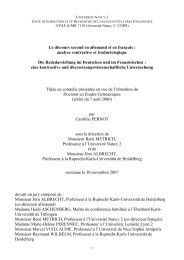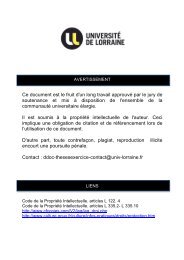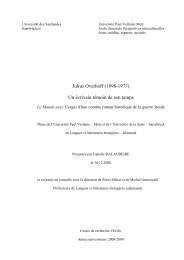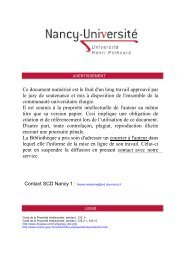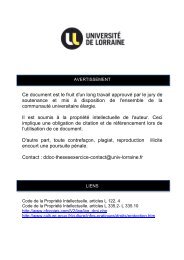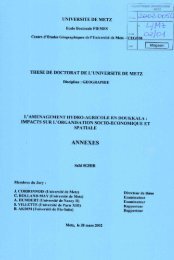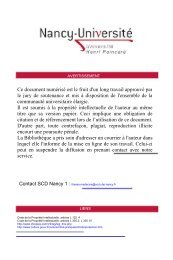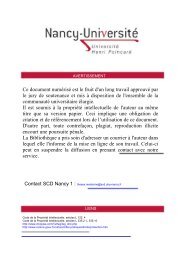Mécanismes d'évolution de texture au cours du recuit d'alliages de ...
Mécanismes d'évolution de texture au cours du recuit d'alliages de ...
Mécanismes d'évolution de texture au cours du recuit d'alliages de ...
You also want an ePaper? Increase the reach of your titles
YUMPU automatically turns print PDFs into web optimized ePapers that Google loves.
Chapitre 6: Croissance <strong>de</strong> grains<br />
cas <strong>du</strong> laminage simple. Ceci concor<strong>de</strong> avec le fait que les tailles mesurées <strong>de</strong> ces gros<br />
grains sont moins importantes (90µm contre 140µm dans le cas <strong>du</strong> laminage simple).<br />
fraction <strong>de</strong> population (%)<br />
a) laminage à 40% b) laminage à 50%<br />
fraction <strong>de</strong> population (%)<br />
100<br />
90<br />
80<br />
70<br />
60<br />
50<br />
40<br />
30<br />
20<br />
10<br />
0<br />
0 10 20 30 40 50 60 70 80 90 100<br />
100<br />
90<br />
80<br />
70<br />
60<br />
50<br />
40<br />
30<br />
20<br />
10<br />
fraction surfacique (%)<br />
LC40-700°C 24h<br />
LT40-700°C 24h<br />
0<br />
0 10 20 30 40 50 60 70 80 90 100<br />
fraction surfacique (%)<br />
LS80-700°C 24h<br />
LC80-700°C 24h<br />
LT80-700°C 24h<br />
c) laminage à 80% d) laminage transverse<br />
Figure 6-11: Zr702: distribution <strong>de</strong> tailles <strong>de</strong> grains après 24h <strong>de</strong> traitement à 700°C pour<br />
différents cas <strong>de</strong> déformation<br />
La dispersion <strong>de</strong>s tailles <strong>de</strong>s gros grains est légèrement moins importante pour le<br />
laminage transverse à 80% que pour le laminage croisé <strong>au</strong> même t<strong>au</strong>x. L'examen <strong>de</strong> la<br />
figure 6-11 d) montre par ailleurs la forte similitu<strong>de</strong> entre les distributions pour les<br />
différents t<strong>au</strong>x <strong>de</strong> laminage transverse, ce qui est cohérent avec le fait que nous n'ayons<br />
constaté <strong>de</strong> croissance anormale dans <strong>au</strong>cun <strong>de</strong> ces cas.<br />
0<br />
0 10 20 30 40 50 60 70 80 90 100<br />
En ce qui concerne le Titane, les distributions <strong>de</strong> taille <strong>de</strong>s grains sont similaires à celles<br />
<strong>du</strong> Zirconium, et sont assez stables <strong>au</strong> <strong>cours</strong> <strong>de</strong> la croissance. Un examen attentif <strong>de</strong> la<br />
figure 6-12 permet <strong>de</strong> noter une très légère diminution <strong>de</strong> la population <strong>de</strong>s plus petits<br />
fraction <strong>de</strong> population (%)<br />
fraction <strong>de</strong> population (%)<br />
100<br />
90<br />
80<br />
70<br />
60<br />
50<br />
40<br />
30<br />
20<br />
10<br />
100<br />
90<br />
80<br />
70<br />
60<br />
50<br />
40<br />
30<br />
20<br />
10<br />
fraction surfacique (%)<br />
LS50-700°C 24h<br />
LC50-700°C 24h<br />
LT50-700°C 24h<br />
0<br />
0 10 20 30 40 50 60 70 80 90 100<br />
fraction surfacique (%)<br />
LT80-700°C 24h<br />
LT60-700°C 24h<br />
LT50-700°C 24h<br />
157


